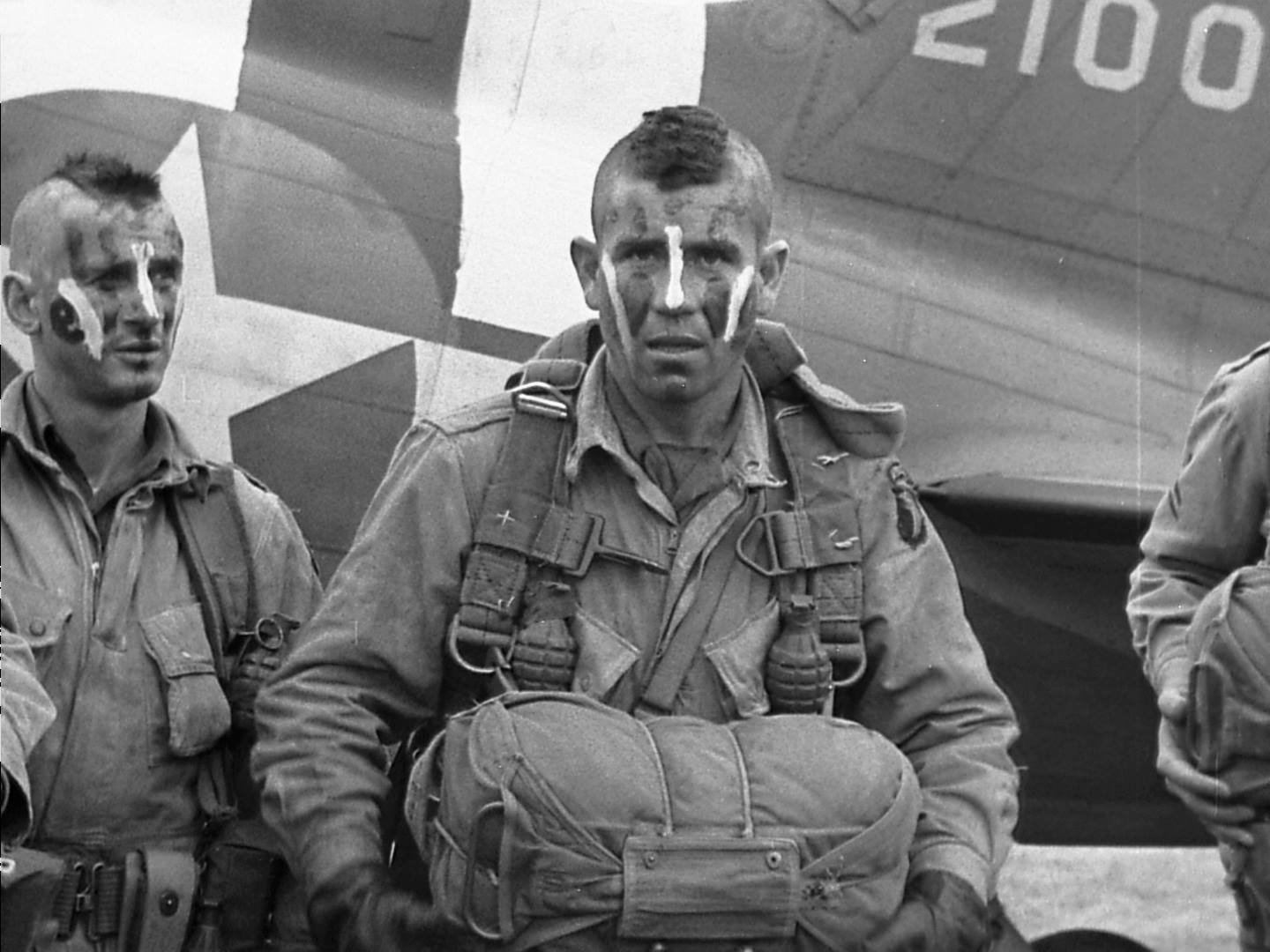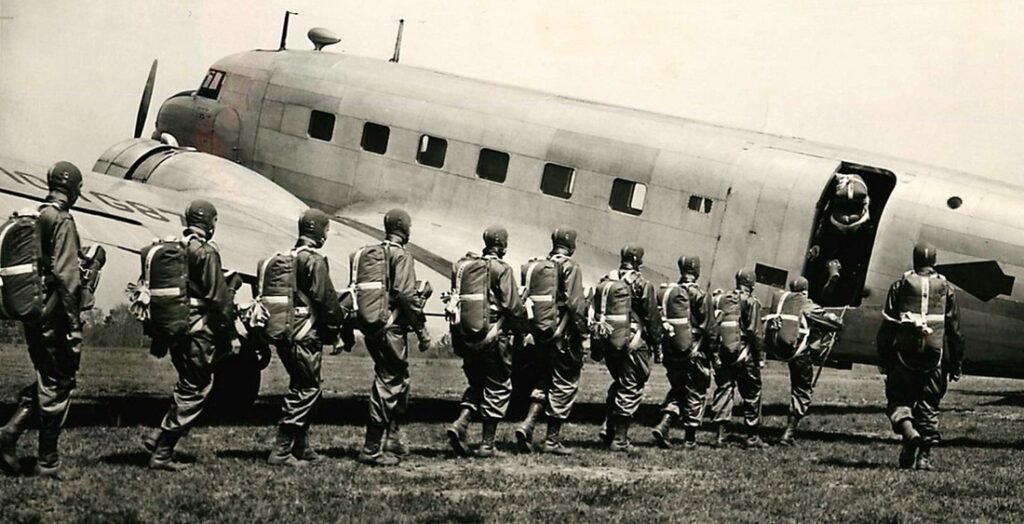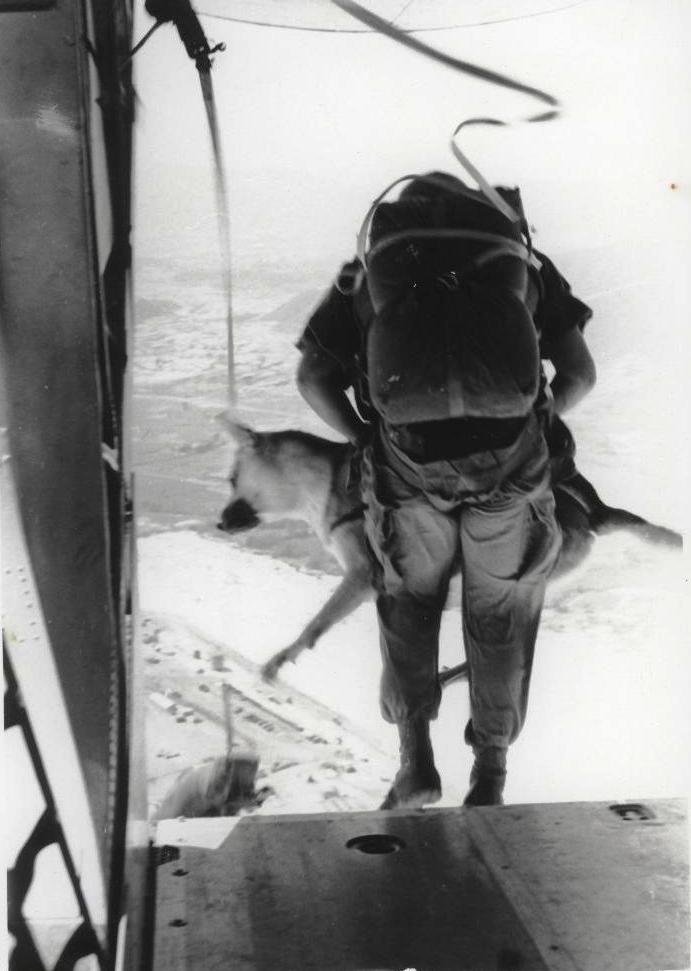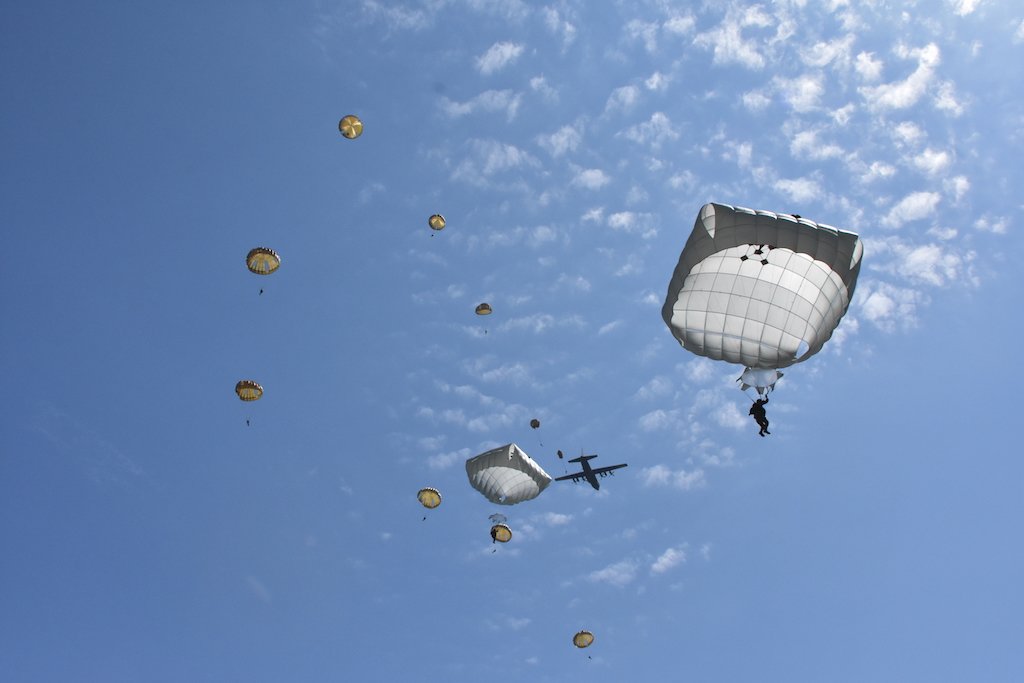
“Old Man” Tommy Lonergan, a member of the Filthy Thirteen, looks at the camera with his buddy Johnny “Peenuts” Hale behind him. Photo courtesy of the book “Warpaint: The Filthy Thirteen Jump Into Normandy.”
Even though the U.S. Army had plans to implement sky soldiers as early as World War I, American paratroopers may have arrived late to the airborne scene — Soviet engineers had innovated parachute designs and German Fallschirmjägers had completed airborne operations over Norway at the beginning of World War II.
The U.S. Army’s 29th Infantry Regiment formed a test platoon and conducted their first ever training jump in August 1940. Two years later, the 509th Parachute Infantry Regiment completed their first major implementation of airborne combat troops during Operation Torch in support of the amphibious invasion in North Africa.
World War II was the battlefield that tested the capabilities of static-line parachutes. They continue to be a presence on modern day battlefields, but they have seen several renditions and undergone modifications to advance the functionalities that many paratroopers are familiar with today.
T-4 Parachute

Before the U.S. Army was hurling full-grown human beings outside of its plane’s doors, they ran test drops using paradummies. “Dummy Joe,” a makeshift human composed of sandbags with a parachute equipped on its back, made 5,000 jumps from 1918 to 1924. The T-4 static-line parachute was 28 feet in diameter under canopy and was said to be the first parachute designed for combat use.
On April 23, 1941, 107 dummy drops were completed at Wright Field in Dayton, Ohio. According to research conducted by Joshua DeJong at The Rigger Depot, The paratroopers inside the plane used Lineman’s static-line hooks that were often used by technicians that climbed up and down electrical wires. The Hook 41B3674 added a safety pin feature that improved the safety of the paratroopers.
When paratroopers leapt from their plane, the static-line parachute automatically deployed the top of the parachute from their backpack and released the canopy followed by the rigging lines. The Americans were the only airborne troops in World War II to use a reserve parachute. It rested below their chest toward their stomach and could be pulled in case of a malfunction. The placement of the reserve chute was an important feature because they also had pockets of extra ammunition, rations, or demolitions on their chest.
Engineers recognized the limitations of the T-4 parachutes because they had a variety of issues, the most apparent being that the parachute deployed before the rigging. This resulted in a paratrooper falling at 120 mph before being yanked to a violent hover as they floated under canopy to the landing zone. These issues were looked at in later modifications.
T-5 & T-7 Parachutes
Three prototypes for the T-5 parachute were tested to solve the problems of the T-4, but not all of them were successful. In February 1942, Snap hook closures from Hook 42B3232 improved the risk of accidentally unhooking from the static-line cord. It had a vertical sliding gate and spring-loaded button that allowed for jumpers to slide along at their own controlled pace before exiting the aircraft. The initial training T-5 rigs had all white canopies, but since they are easy to spot in the air, they were replaced with camouflage chutes for later airborne operations.
The pre-deployment of the parachute before the rig couldn’t be resolved. More than 13,000 paratroopers of the 82nd Airborne Division and 101st Airborne Division — along with British, Canadian, and other Allied paratroopers — parachuted into Normandy on D-Day and lost equipment, including hand grenades that flew from their pockets.

The T-5 parachute rigs also had an Irving quick-release mechanism box, sometimes called the “bang box,” which allowed paratroopers to release themselves from their harness without delay once they were on the ground. Their reserve chutes had hesitator loops and pilot chute flaps that deployed when the original red ripcords were pulled. T-5’s were the most widely used parachutes during World War II and were used during Operation Market Garden, which saw more than 20,000 Allied troops dropped by parachute via airplanes. Toward the end of the war, more than 16,000 paratroopers participated in Operation Varsity, the last and largest one-day airdrop of the war.
The T-5 was phased out before the Korean War, and the Army emphasized the inclusion of the T-7 parachute. The T-7 had a serious issue in malfunctions caused by the increased speeds with which airplanes traveled. The wind speeds caused wear and tear on the chutes, and from June 30, 1951, to June 30, 1952, investigations reported that 12 fatalities were caused by these malfunctions.
A 1944 report found the average speed a plane was traveling during an airborne training operation was just 100 mph, and even then the opening of the parachutes caused canteens, holsters, and helmets to be ripped from paratroopers’ gear. The C-119s that were used post-World War II averaged speeds of 145 mph and called for an innovation of the T-7 design to prevent catastrophic injuries from occurring even before landing on the ground.
T-10 & T-11 Parachutes

While there were some failed prototypes in between, the T-10 rose to be the premier parachute used by American Airborne troops from the 1950s until its retirement in 2014. The proven history was ingrained into Airborne culture.
On average, the typical weight of a combat load consisted of 300 pounds of equipment. These combat loads were seen throughout Operation Junction City, when 800 paratroopers jumped in to destroy the Viet Cong’s central command post during the Vietnam War; Operation Urgent Fury, which had a portion of 6,500 troops air assault into Grenada; Operation Just Cause, when the 82nd completed their first combat jump since World War II in Panama; and in modern wars such as Iraq and Afghanistan.
The parachute in use today is the T-11 Advanced Tactical Parachute System (ATPS), which was first introduced in 2007. The T-11 rig comes with a harness, a T-11R reserve parachute, and a main square-shaped canopy parachute. The Army abandoned the T-10 because of the frequent injuries associated during airborne operations, and early reports indicated that the T-11 had reduced injury rates by 75 percent. However, as recently as 2016, fatalities using the T-11 presented unsolved challenges in the adjustment of training and procedures to ensure the safety of their paratroopers.
Editor’s note: Several corrections were made to this article after it was originally published, including that the Hook
41B3674 added a safety pin feature that was entirely safe and did not unhook; that the T-4 did not have a single-point quick release; that the T-5’s were the most widely used parachutes during World War II; that the T-5 was phased out before the Korean War began, not during the war; and that the average aircraft speed of 100 mph referred to airborne training operations.

Matt Fratus is a history staff writer for Coffee or Die. He prides himself on uncovering the most fascinating tales of history by sharing them through any means of engaging storytelling. He writes for his micro-blog @LateNightHistory on Instagram, where he shares the story behind the image. He is also the host of the Late Night History podcast. When not writing about history, Matt enjoys volunteering for One More Wave and rooting for Boston sports teams.
BRCC and Bad Moon Print Press team up for an exclusive, limited-edition T-shirt design!
BRCC partners with Team Room Design for an exclusive T-shirt release!
Thirty Seconds Out has partnered with BRCC for an exclusive shirt design invoking the God of Winter.
Lucas O'Hara of Grizzly Forge has teamed up with BRCC for a badass, exclusive Shirt Club T-shirt design featuring his most popular knife and tiomahawk.
Coffee or Die sits down with one of the graphic designers behind Black Rifle Coffee's signature look and vibe.
Biden will award the Medal of Honor to a Vietnam War Army helicopter pilot who risked his life to save a reconnaissance team from almost certain death.
Ever wonder how much Jack Mandaville would f*ck sh*t up if he went back in time? The American Revolution didn't even see him coming.
A nearly 200-year-old West Point time capsule that at first appeared to yield little more than dust contains hidden treasure, the US Military Academy said.












